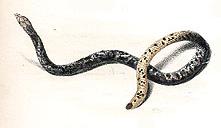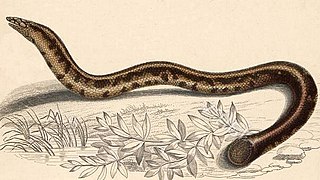The Uropeltidae, also known commonly as the shieldtails or the shield-tailed snakes, are a family of primitive, nonvenomous, burrowing snakes native to peninsular India and Sri Lanka. The name is derived from the Greek words ura ('tail') and pelte ('shield'), indicating the presence of the large keratinous shield at the tip of the tail. Seven or eight genera are recognized, depending on whether Teretrurus rhodogaster is treated in its own genus or as part of Brachyophidium. The family comprises over 50 species. These snakes are not well known in terms of their diversity, biology, and natural history.
Platyplectrurus trilineatus, commonly known as the Tri-striped shieldtail snake or the lined thorntail snake, is a species of uropeltid snake endemic to the Western Ghats of Southern India. Like most other shieldtail snakes, it is presumed to be a nocturnal, fossorial snake inhabiting evergreen forests. A very rare snake, about which nothing is known in terms of live colouration and natural history.
Rhinophis oxyrhynchus, also known as Schneider's earth snake or Schneider's shieldtail, is a species of uropeltid snake endemic to Sri Lanka.
Uropeltis ceylanica is a species of nonvenomous shieldtail snake in the family Uropeltidae. The species is endemic to the Western Ghats of South India. No subspecies are currently recognized as being valid, but the presence of several synonyms, many recently resurrected, calls for further taxonomic studies of this species complex. It is a burrowing snake with a pointy head equipped to penetrate the soil. It has a thick tail which looks as if it has been cut at an angle. In Kerala it's called iru thala moori, which means two headed organism, as the tail end looks like another head. It primarily eats earth worms.
Uropeltis dindigalensis, commonly known as the Dindigul uropeltis and the Sirumalai Hills earth snake, is a species of snake in the family Uropeltidae. The species is endemic to Sirumalai and surrounding hill ranges of the southern Eastern Ghats, in Dindigul district of Tamil Nadu state in South India.
Uropeltis ocellata is a species of non-venomous shieldtail snake in the family Uropeltidae. The species is indigenous to southern India. There are no subspecies that are recognized as being valid.
Smith's earth snake, also known commonly as the violet shieldtail, is a species of nonvenomous snake in the family Uropeltidae. The species is endemic to India.
Uropeltis is a genus of nonvenomous shield tail snakes endemic to peninsular India. As of 2022, 26 species are recognized as being valid.

Rhinophis is a genus of nonvenomous shield tail snakes found in Sri Lanka and South India. Currently, 24 species are recognized in this genus. Of the 24 species, 18 are endemic to Sri Lanka, while 6 are endemic to South India.

Rhinophis saffragamus, the large shieldtail snake, is a species of snake in the family Uropeltidae, which is endemic to the island of Sri Lanka. No subspecies are currently recognized.
Teretrurus rhodogaster is a species of nonvenomous shield tail snake, endemic to the Western Ghats of India. It is known as Wall's shield tail snake, Palni Mountain burrowing snake, or red-bellied shieldtail.
Rhinophis blythii, or Blyth's earth snake, is a species of snake in the family Uropeltidae. The species is endemic to the rain forests and grasslands of Sri Lanka.
Rhinophis drummondhayi, commonly known as Drummond-Hay's earth snake, is a species of snake in the family Uropeltidae. The species is endemic to Sri Lanka.
Cnemaspis alwisi, also known commonly as Alwis' day gecko or Alwis's day gecko, is a species of diurnal lizard in the family Gekkonidae. The species is endemic to the island of Sri Lanka.
Nessia deraniyagalai, commonly known as Deraniyagala's snake skink, Deraniyagala's snakeskink, or Deraniyagala's nessia, is a species of limbless lizard in the family Scincidae. The species is endemic to the island of Sri Lanka.
Rhinophis zigzag, or Zigzag Shieldtail, is a species of snake in the Uropeltidae family. It is endemic to Sri Lanka.
Rhinophis roshanpererai, the Roshan Perera's shieldtail or Roshan Perera's rhinophis, is a species of snake in the family Uropeltidae. It is endemic to Sri Lanka. The species was first described from three specimens taken from Badulla District. The species lack pale stripes and possess three to four prominent spines with a small shield-tail.

Rhinophis goweri, also known as Gower's shieldtail snake, is a recently described, little-known species of snake of the family Uropeltidae. It is endemic to the Eastern Ghats of Tamil Nadu in South India.

Uropeltis madurensis, also known commonly as the Madura earth snake and the Madurai shieldtail, is an endangered species of small, fossorial, nonvenomous snake of the family Uropeltidae. The species is endemic to the Western Ghats of South India.




